
by F. Todd Davidson and Michael E. Webber Friday, June 26, 2015
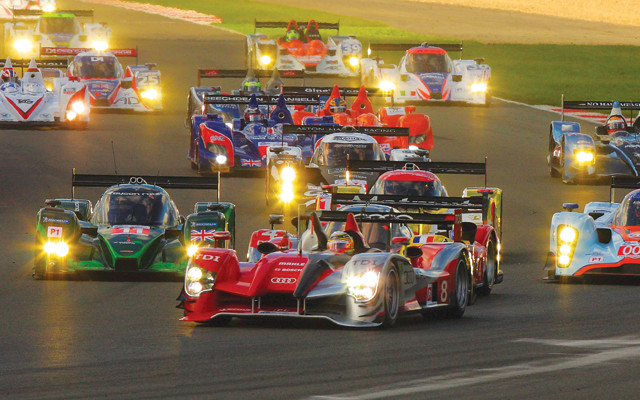
The 24-hour Le Mans race is part of the World Endurance Championship (WEC) race series, in which prototypes of the next generation of cars test the limits of speed, endurance and safety. Credit: ©Adrian Hoskins, CC BY 2.0.
“High-performance” and “environmentally friendly” are two phrases not commonly used together to describe race cars. But at the World Endurance Championship (WEC), it’s par for the course. These prototypes are the next generation of cars, testing the limits of speed, endurance and safety. And in just a few years, they may be coming to a lot near you.
The WEC racing series pits some of the world’s most advanced machines against one another, pushing the boundaries of science and engineering, and giving us a glimpse into the future of automotive transportation. The series typically consists of eight races that occur in cities all over the world: seven six-hour-long races and the famous 24-hour race in Le Mans, France.
The duration of each race requires the cars to optimize speed, efficiency and durability. The most advanced cars are fielded by well-funded teams backed by recognizable brands. In recent years, Toyota, Audi and Porsche have led the pack and are in a tight battle to earn their place on the podium. One of the most interesting aspects of the WEC is that its rules only place loose bounds on the accepted design and operation of the vehicles. The result is a fascinating case study of how unbridled competition can produce unique, innovative and extraordinary solutions to engineering barriers once thought intractable.
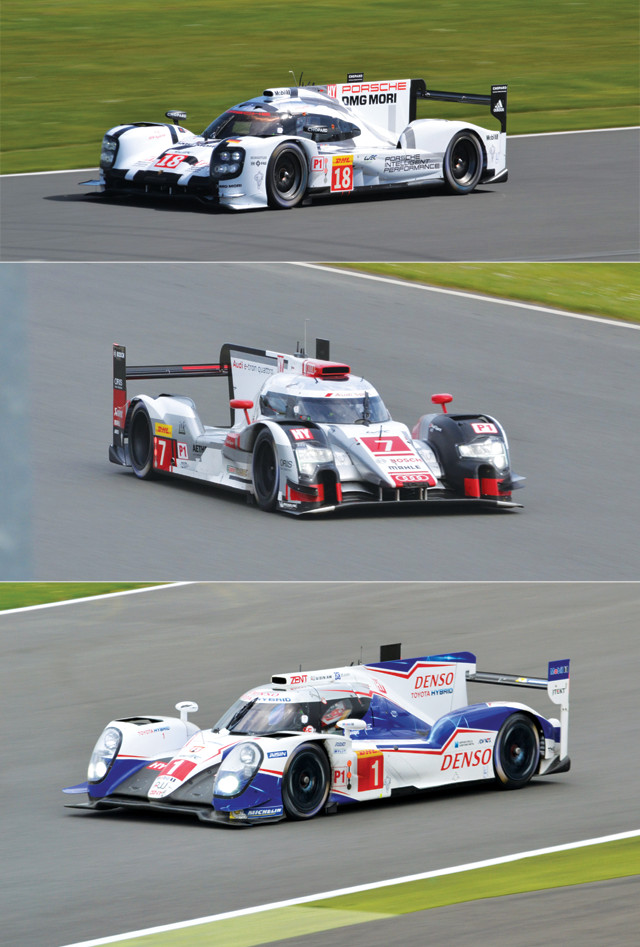
Porsche, Audi and Toyota (from top to bottom) battle for supremacy at the WEC. Each carmaker is relying on a different brake regeneration system using different electrical- energy storage devices — an arena in which cars will make the biggest leaps in the near future. Credit: all: ©jambox998, CC BY-NC-ND 2.0.
For everyday drivers, the innovations that emerge from the racetrack ripple down to the commercial car lot, saving us money at the gas station while also making our cars safer and more fun to drive.
The first 24-hour race at Le Mans took place in 1923 and was won by André Lagache and René Léonard. The two Frenchmen drove a Chenard & Walcker vehicle with a 3.0-liter, inline four-cylinder engine — akin to the standard engine of a modern sedan — which achieved an average speed of 52.7 miles per hour (mph) during the race. The car was state-of-the-art at the time, and helped catalyze the initial popularity and subsequent longevity for what is one of the longest-running motorsport events in the world.
Over the years, the original race has changed little. It’s still run in the small town of Le Mans, it’s still 24 hours long, and the contestants still consist of small teams of drivers and their support crews. But, there’s one thing that is dramatically different: the cars.
In recent years, the auto-racing community has tried to improve its environmental image. Burning tanker-truckloads of fuel to whip around asphalt tracks, while at the same time chewing through countless rubber tires, strikes some observers as gluttonous. The biggest recent change is teams’ adoption of hybrid drive trains requiring onboard electricity storage as a fuel-saving technology, resulting in the race cars becoming the world’s fastest hybrid automobiles.
Many auto-racing enthusiasts initially complained, worried that race teams had caved to political pressure from environmentalists. They imagined heavy batteries weighing cars down, slowing their pace, and making races less exciting. But these advanced hybrids are delivering faster track times while consuming less fuel. High-performance and environmentally friendly have indeed merged on the racetrack.
In conjunction with onboard electricity storage, these modern race cars use whisper-quiet electric motors alongside throaty combustion engines to increase total horsepower. They also use brake regeneration technology to convert the energy lost from slowing vehicles down into electrical energy stored onboard the vehicle. The benefits of these systems are profound.
One example is the latest Le Mans prototype developed by the Toyota racing team. The TS040 prototype is powered by a 3.7-liter, V-8 engine that produces 513 horsepower — more than three times the power of a Toyota Corolla. The TS040 captures additional power, stored in a bank of supercapacitors, from the braking system. As the driver exits a turn, the energy stored in the capacitors can be released to accelerate the car. At the push of a button — just like in video games — the driver of the Toyota TS040 can pour an additional 473 horsepower into the wheels — twice what the car started the race with — rocketing the car forward with torque-on-demand electric motors and a 0–60 mph time of about 3 seconds.
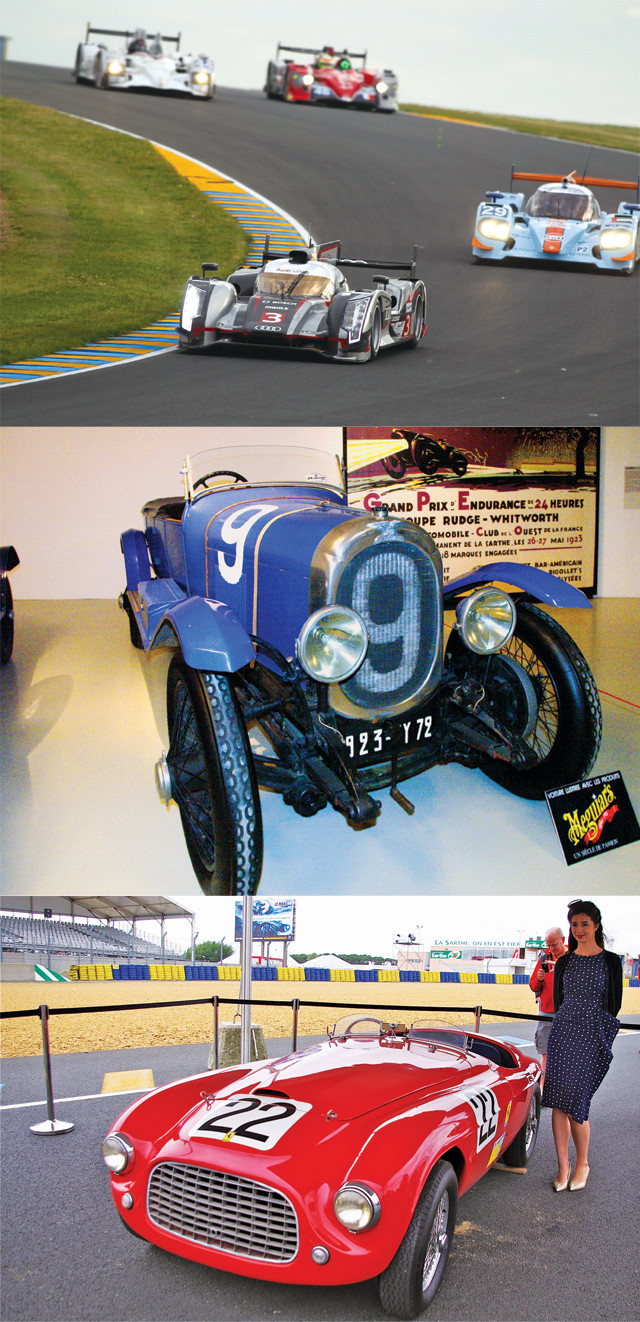
The Le Mans race has been run since 1923, when a Chenard & Walcker sports car won the first race (middle). Over time, many different car manufacturers have won, including Ferrari (bottom, the 1949 winner). Credit: top: ©Le Mans Live Michelin, CC BY-NC-ND 2.0; middle and bottom: ©David Merritt, CC BY 2.0.
One of the fascinating aspects of the ongoing battle among Audi, Porsche and Toyota is that they have all chosen to implement their brake regeneration systems using different electrical energy storage devices — and it is in this arena that cars will make the biggest leaps in the near future. The three teams compete with flywheels, lithium-ion batteries and supercapacitors, respectively. Not only are the companies trying to prove that they have the fastest cars, but fans and car owners are getting front-row seats to the competition to see which next-generation storage technology will enable high-performance electric vehicles for the common man.
Comparing the energy storage systems of the three teams requires an understanding of the difference between energy and power. Think of energy as the amount of water held in a container. The more water in the container, the more energy it stores. Think of power as being the rate at which the water flows out of the container. If the container has a very large spout, it has a very high power density because the water could flow out very rapidly. Among the three competing onboard energy storage systems, Audi’s flywheel system is the only one that stores energy mechanically, and its design allows for the delivery of very high power. Flywheels work by rotating a high-density body about an axis (think of a heavy top spinning on its end). More energy is stored in the flywheel by accelerating the spinning mass. Energy is extracted from the system by putting a load on the flywheel, which decelerates the spinning mass.
Porsche uses electrochemical batteries in its WEC race cars, which store and release energy with chemical reactions. Electrochemical energy storage is the method by which common batteries operate. The batteries Porsche has installed for the 2015 race season have the highest total energy storage capacity of any of the three major competitors. But, the rate at which the energy can flow out of the Porsche batteries is lower compared to Audi’s flywheel and Toyota’s supercapacitors. For actions requiring high power, like severe braking, these batteries are subjected to significant stress and high levels of heat generation, which can cause damage and limit the batteries’ cycle-life — a measure of how many times a battery can be charged and discharged before losing performance. To counter these drawbacks, the Porsche team has implemented a liquid-cooling system to keep the battery system operating within acceptable temperatures and maintain a high level of performance throughout the endurance races. Unfortunately, the cooling system comes with the drawback of adding weight to the car.
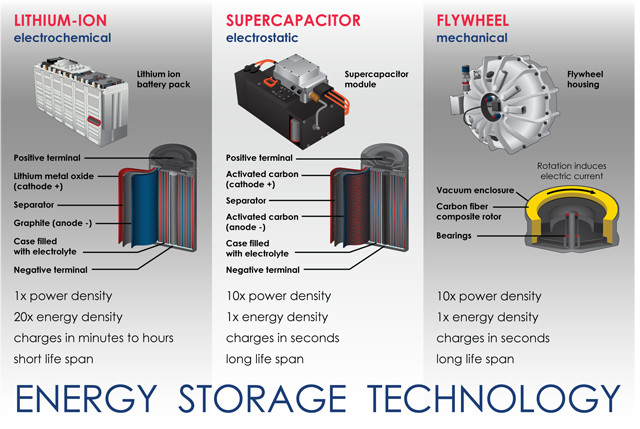
In their WEC race cars, Porsche, Toyota and Audi use different energy storage systems, each of which has unique features and specifications. Porsche uses lithium-ion batteries, Toyota uses supercapacitors and Audi uses a flywheel system. Credit: K. Cantner, AGI.
Toyota’s supercapacitors have significantly higher cycle-life and durability than typical batteries because they store and release energy electrostatically — imagine the electrostatic shock that zaps you when the air is dry and you touch a doorknob, except on a much larger scale. Storing energy electrostatically rather than chemically allows supercapacitors to more effectively handle high-frequency, high-power events, such as the rapid charging and discharging conditions that are present on the racetrack as a car enters and exits turns at close intervals. However, supercapacitors cannot hold as much energy as electrochemical batteries like Porsche’s lithium-ion system. Thus, Toyota installs more supercapacitors than it otherwise might in its race cars, which adds weight. Still, Toyota built an extremely competitive system: The Toyota team won the 2014 World Endurance Championship, suggesting that supercapacitors might be a promising solution to help future electric vehicles handle high-power events.
While supercapacitors offer fast charging and discharging, have stable performance over a range of temperatures, and can be cycled many times without losing effectiveness, they can only store 10 to 20 percent of the energy that old-fashioned lead-acid batteries can, and about 5 percent of what modern lithium-ion batteries can. Overcoming the supercapacitor’s limitations remains a vexing problem.
Looking for potential improvements in materials — which are behind many great engineering advancements — is a promising place to start. And one possible route to improving the energy density of supercapacitors is to improve the performance of the material used to construct electrodes.
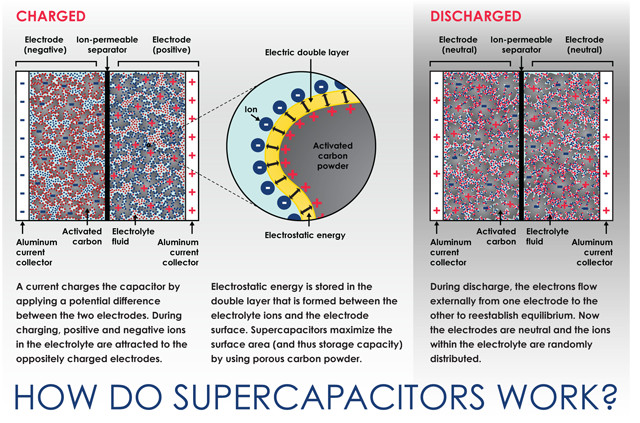
The electric charge in a capacitor is stored in the form of electrostatic forces, rather than in the potential of chemical reactions as in traditional batteries. Credit: K. Cantner, AGI.
Typical supercapacitor electrodes are made from carbonaceous materials such as coconut shells. On a fundamental level, the system operates by exchanging charged ions from one carbon electrode to the other while simultaneously delivering an electrical current through the connected circuit. The more ions that can access the carbon electrodes, the more charge the system can deliver and the more energy it can store. Hence, increasing the surface area of the carbon electrode material can lead to higher storage capacity.
One promising material for next-generation supercapacitors is graphene. Graphene — composed of single-atom-thick layers of carbon — was the focus of the 2010 Nobel Prize in Physics and has been praised for its potential applications in a wide range of industries, including electrical energy storage.
One of the most exciting properties of graphene is its extraordinarily high theoretical surface area: up to 2,630 square meters of surface area per gram of material. To put that in perspective, a single ounce of graphene has the equivalent surface area of approximately 17 American football fields. With that much surface area in electrodes, graphene-based supercapacitors could theoretically store more charge than commercially available supercapacitors.
Materials like graphene aren’t commercially ready yet, but in the near future they could improve the performance of supercapacitors, which means they would be welcomed on racetracks. The proving grounds of racing will then help these next-generation materials and electrical-energy storage devices transition into the commercial marketplace.
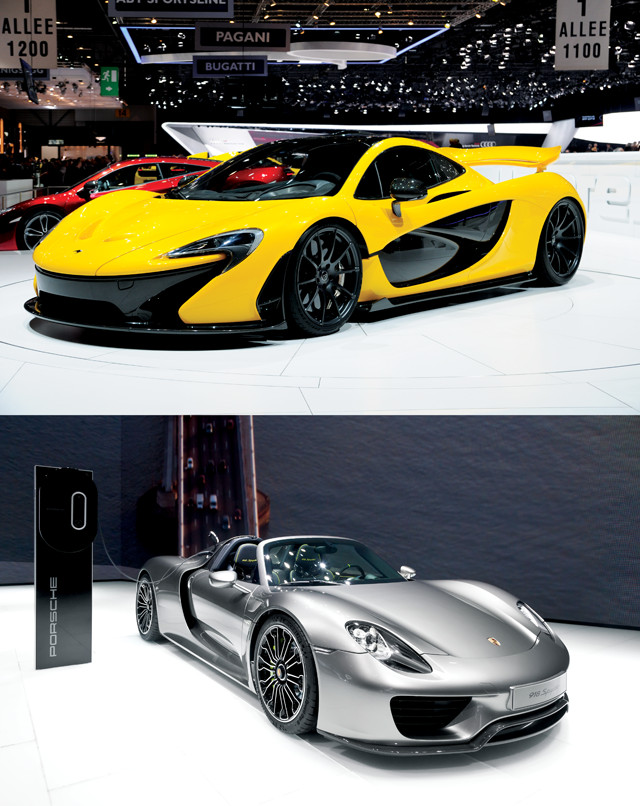
The McLaren P1 (left) and the Porsche 918 (below) are the latest supercars to deliver previously unimagined performance, achieving these results with hybrid drive trains similar to the Le Mans prototypes while improving fuel economy dramatically, compared to conventional sports cars. Credit: top: ©Norbert Aepli, CC BY 3.0; bottom: ©Thomas Wolf, CC BY-SA 3.0 de.
But, innovation in the race for automobile efficiency isn’t limited to supercapacitors. Relatively energy-dense lithium-ion batteries are very light in comparison to supercapacitors. And more advanced batteries currently under development will push energy density even higher. Tesla Motors, for example, is making major bets on not only increasing the energy density of lithium-ion batteries but also driving down the manufacturing costs at its highly anticipated Gigafactory. Using these batteries, Tesla expects to offer its Model 3, an electric car priced at an estimated $35,000, to the marketplace within the next three years. Of course, to bring all of this to market will require using a mix of minerals and advanced raw materials sourced from around the planet; whether global mining and manufacturing capacity can keep up if demand surges remains to be seen. And then, of course, there’s the task of overcoming substantial technical hurdles in boosting battery performance while bringing down costs.
Next-generation electrical-energy storage devices will be key to extending the range of electric vehicles and achieving future fuel-efficiency standards. The Bush and Obama administrations both set strict goals for Corporate Average Fuel Economy (CAFE): The latest standards require cars to achieve 54.5 miles per gallon (mpg) on average by the year 2025, roughly double the performance of cars on the road today. Achieving the 54.5-mpg level of performance would return significant benefits to the United States by reducing our oil consumption.
Achieving a fleetwide CAFE standard of 54.5 mpg is no trivial matter, though, and it may result in a noticeable increase in sticker price. Car manufacturers are considering an all-of-the-above strategy by improving almost every single component on modern cars to achieve that level of performance while trying to bring down costs. These improvements will include cutting weight with materials such as aluminum, carbon fiber and composites; optimizing aerodynamics; and minimizing the impact of loads, such as air conditioning, that are drags on performance. Ford recently made headlines with the announcement of its aluminum-bodied F-150 truck, which will improve the vehicle’s efficiency dramatically by significantly reducing weight. In addition to these improvements, vehicle manufacturers are finding better and smarter ways to incorporate electrification to improve fuel economy.
One of the more promising and ready-to-implement pathways for vehicle electrification is the use of microhybrid technology. Whereas a full hybrid, like a Toyota Prius, uses electrification to power most of its operations, microhybrid vehicles use a small amount of electrification to improve the fuel efficiency of a vehicle. Microhybrids have improved a lot in recent years, thanks to lessons learned from existing hybrids and from the racetrack. They now have the ability to store energy through brake regeneration and to shut the engine off while the car idles.
The 2016 Mazda 6, a microhybrid sold in the U.S., for example, can disengage the alternator from the engine, improving fuel efficiency. To do so, the car uses a bank of supercapacitors to supply electric power while the alternator is disengaged. For a few hundred dollars of hardware, auto manufacturers are able to improve fuel efficiency by almost 10 percent. The result is that microhybrids have the highest marginal return on investment for saving fuel of any hybridization technology.
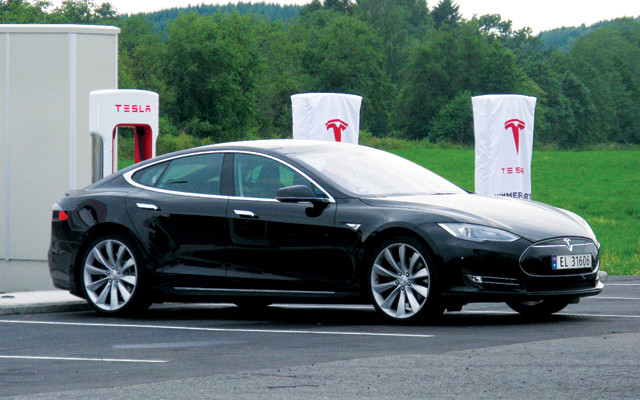
Tesla Motors is making major bets on not only increasing the energy density of lithium- ion batteries but also driving down the manufacturing costs. Credit: ©Nakhon100, CC BY 2.0.
More than half of vehicles in Europe are already microhybrids, which are offered by nearly every major car manufacturer. The adoption of this technology in the U.S. has been slower because of our lower fuel efficiency and different emissions standards. But this trend is changing due to the new CAFE targets and the introduction of new vehicles. Microhybrid technology will inevitably become part of the all-of-the-above strategy to improve fleetwide fuel efficiency.
The world is beginning to see hybrids in a whole new way. The McLaren P1 and the Porsche 918 are the latest supercars to deliver previously unimagined performance, achieving these results with hybrid drive trains similar to the Le Mans prototypes while improving fuel economy dramatically, compared to conventional sports cars. These cars have better acceleration than any previous production vehicle in history. And that performance edge is attractive.
The push to make ever faster, more efficient and more durable race cars will translate to improving mass-market vehicle efficiency using electrification. But, the efficiency improvements will inevitably run into the limitations of onboard storage devices. These devices — whether they are batteries, supercapacitors, flywheels or other systems — will require expensive advances and rigorous testing to achieve future efficiency targets. Fortunately, the World Endurance Championship gives entrepreneurs, investors and auto manufacturers the perfect test bed to push the envelope. These race cars will pave the road for our future driving experience, creating automobiles that are not only more exciting to drive but also safer and significantly more fuel efficient.
© 2008-2021. All rights reserved. Any copying, redistribution or retransmission of any of the contents of this service without the expressed written permission of the American Geosciences Institute is expressly prohibited. Click here for all copyright requests.